Writing blog posts could be a fun experience, especially if you’re a physical therapist who wants to stay connected with your audience but there are times when you ran out of topics to discuss. In this article, we’ll share with you the steps on how to start a blog along with several physical therapy blog ideas that will surely add exposure to your clinic!
What are Blog Posts?

Blog posts usually cover any kind of topic that’s relevant to your practice. If you’re looking for ways to increase your site traffic, this is the way to go! Aside from that, it has lots of benefits such as helping you get discovered, attracting new patients, building trust, and keeping your audience engaged.
Interested in publishing blog posts for your physical therapy clinic?
Schedule A Free Strategy Session!
7 Physical Therapy Blog Ideas
Already know how blog posts work but don’t have an idea where to start? Here are several physical therapy blog ideas that will inspire you in writing awesome content for your PT clinic!
If you want your blog to reach a greater number of physical therapy patients, consider using Google Ads as a PT.
1. Address common issues faced by PT patients
Not everyone who searches for physical therapy is on their buying journey. Some are just curious and want to look for more details or ways to instantly relieve muscle or joint pain. To cater to all kinds of readers interested in physical therapy, creating an informative type of blog post could be a good starting point.
Other physical therapy blog ideas to start with are the following:
- “Fall prevention tips for elderly”
- “Tips on how to restore mobility”
- “Tips to reduce joint pain and stiffness”
- “Ways to restore ankle mobility”

Source: ritecaremc.com
2. Life-changing stories from patients
Did you know that you can turn testimonials into stories? Usually, when people are looking for physical therapists, they want to know about their previous patients’ experiences. Detailed reviews from your patients where they mention how your physical therapy services have exceeded their expectations or if you have patients who regularly visit your PT clinic, you could interview them about their experiences (e.g. how they were able to go back to their daily routine, improvements in their mobility, and relieve painful muscle areas).
You could also include your staff. Do an interview on how they feel being a part of a patient’s journey to recovery. That could also be useful for your next blog post!
Like this example:
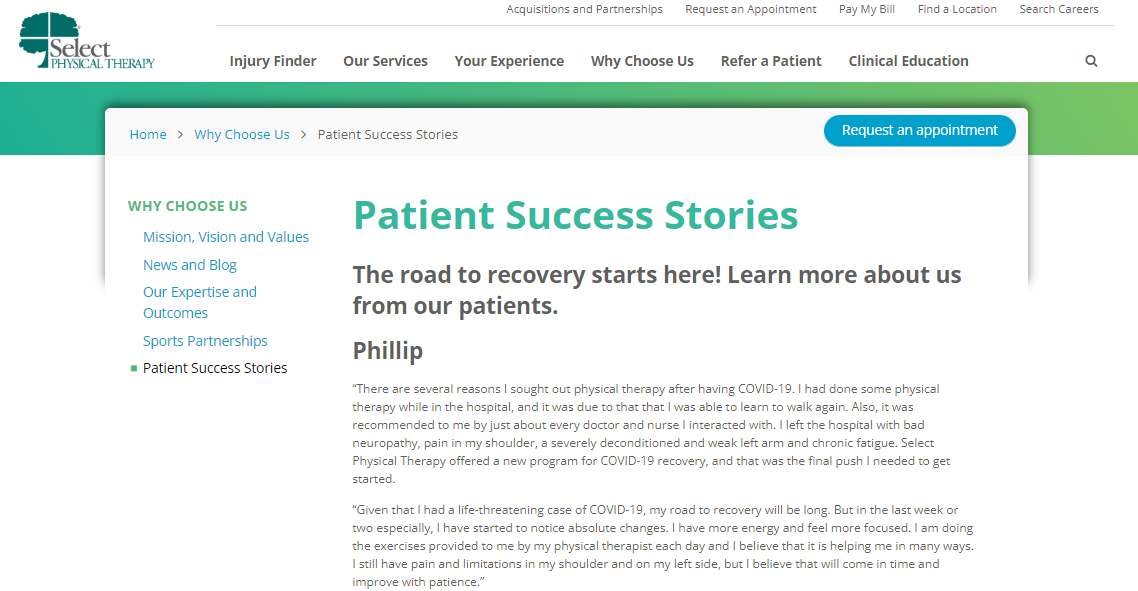
Source: selectphysicaltherapy.com
3. Uncover myths about physical therapy
People are not that aware of the full capabilities that physical therapists can provide. As a PT expert, you want to educate your audience about the common misconceptions about physical therapy. This will not only help them change their perspective on physical therapy but it will also eliminate the spread of misinformation.
Here are a few ideas that you can use to bust those myths with facts:
- Is Physical Therapy Painful?
- Do Physical Therapists “fix” people?
- Physical Therapy is “exercise-based”
- Is physical therapy only for people who got injured or went into an accident?
- Do I need a referral before consulting with a physical therapist?
For example:

Source: choosept.com
4. Facts about physical therapy
Finding facts about physical therapy can be time-consuming especially if it doesn’t have what you are looking for. Writing a blog post that has interesting and random facts about physical therapy is one way of grabbing the interest of your target audience. A well-written factual blog post can even be a stepping stone in turning your page visitors into your actual patients!
Just phrase the title in a way that intrigues a page visitor’s interest. Like this blog post:
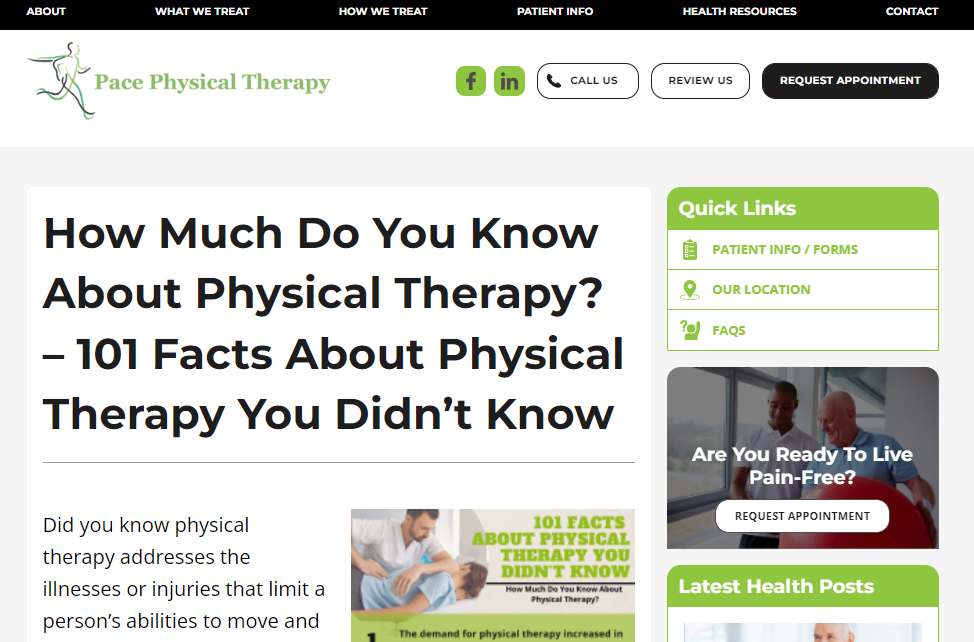
Source: paceptclinic.com
5. At-home physical therapy exercises
Doing exercises at home became more popular due to the pandemic. Since not everyone has their own gym equipment or has enough time to go out, writing tutorials about steps on how to do at-home physical therapy exercises can be a good topic to discuss for your readers.
Other physical therapy blog post ideas are the following:
- “How often should I do physical therapy?”
- “Physical therapy exercises for Seniors”
- “Easy at-home exercises to improve your balance”
- “Practice these exercises to strengthen knees after knee replacement”
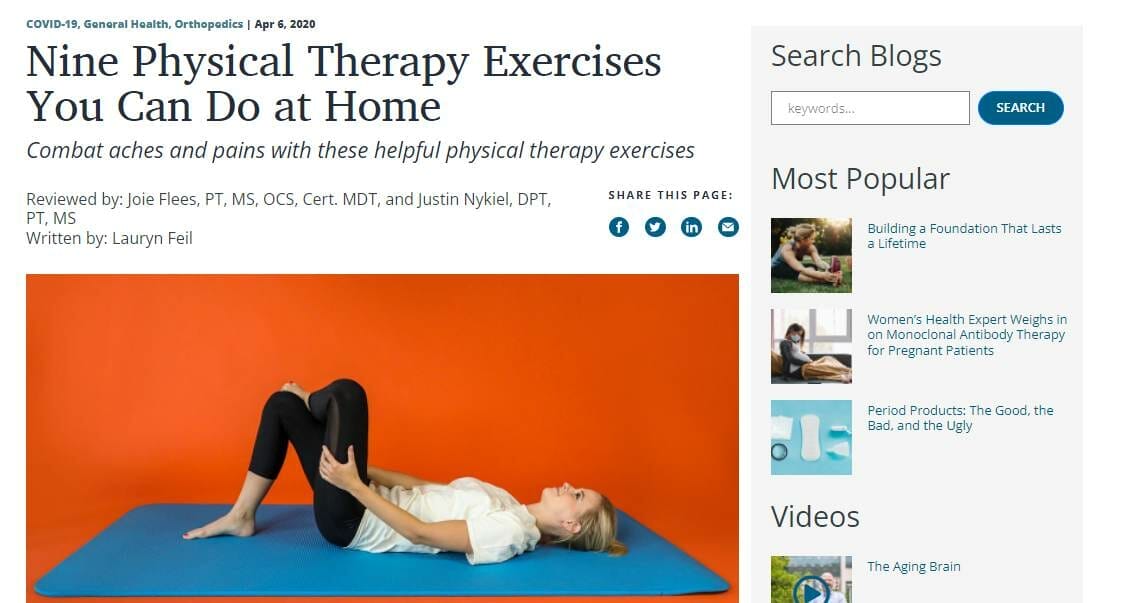
Source: uthealthaustin.org
6. Interview PT experts
Another idea is reaching out to some of the known PT experts. You could either let them do guest blogs or simply interview and feature them on your blog. This will not only expand your network but also raises brand awareness. Just make sure to prepare everything from the script down to the recording equipment so you don’t miss out on the questions you want to ask and things that will be mentioned during the interview.
Here’s an example of a guest blog on a physical therapy website:

Source: liveyourlifept.com
7. FAQs
You’ve probably heard your first-time patients ask the same questions. But did you know that you can turn those questions into a meaningful blog? You can address all of the questions being asked in one post or create separate posts if you want to further elaborate on the topic.
Like in this example:
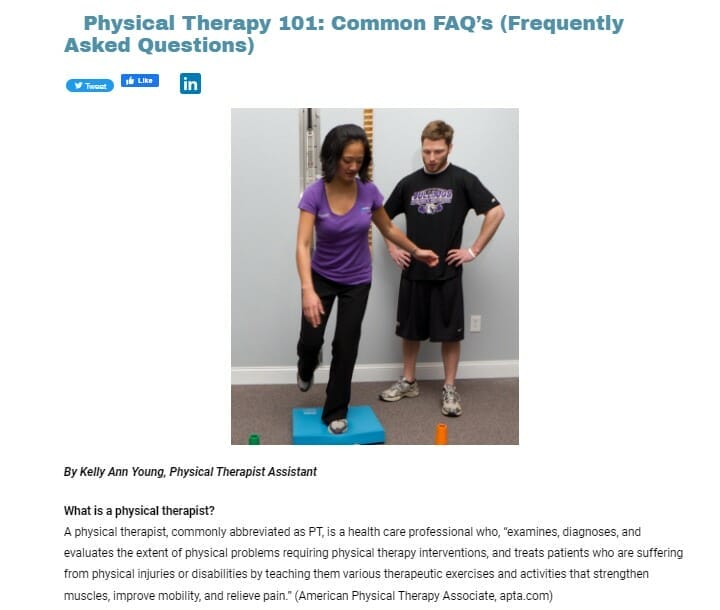
Source: eastpointehealthandfitness.com
Don’t have enough time to write blog posts about your physical therapy clinic?
How to Start a Blog Post for Physical Therapists

1. Choose a topic
Before writing a physical therapy blog post, you have to brainstorm ideas on the topics that you want to share with your audience. Decide on where you’d like to focus (e.g. tutorials, infographics, case studies, personal stories, or controversial topics about physical therapy). Pick a niche and from there, you’ll make it easier to come up with subtopics for your future blog posts.
2. Do keyword research
Have you checked what keywords your competitors are using? Looking at what your competitors are doing for the keyword helps you compare the keywords they’re using, get ideas for the keywords that they probably missed, and use them on the blog post you are planning to work on. Use Ctrl + F to find how many times a keyword is used.
Go for long-tail keywords this helps you reach a specific target audience. For example, you want to write a blog post about “physical therapy exercises.” That keyword may receive tons of searches but it would be impossible to appear on top results because the competition for that keyword is extremely high.
So, you might want to use “physical therapy exercise for the elderly” or “physical therapy for lower back pain” to be more specific and cater a specific group of audience (e.g. older adults who are looking for physical therapy exercises or caregivers helping seniors do exercises at home).
Check out our blog post on How to Find the Right Physical Therapy Keywords to learn more.
4. Choose a blogging platform
Let’s say you’ve already chosen a topic and conducted keyword research. The next thing to do is to choose a platform to write and publish your blog posts. One thing to keep in mind when choosing a blogging platform, you should match it based on your goals and needs.
Some of the factors that you should consider are budget, features, customization, skill level, and usability. WordPress and Squarespace are two of the best blogging platforms out there.
5. Start writing your physical therapy blog
If you’re in this section, you probably have your topics, keywords, and blogging platform prepared. This time, you’ll start writing your first piece. But before that, take look at what type of pages are frequently published with your chosen keyword.
Is it a long-form article, product page, or a Top 10 list? When writing a blog post, it should be about something that tackles relevant topics that are discussed by your competitors (e.g. pediatric physical therapy exercises). Not only that, but you also have to make sure that you are writing a piece that will satisfy what the user is searching for.
Need help in writing your first physical therapy blog post?
8 Best Practices for Physical Therapy Blogs

When writing blog posts, your role doesn’t end with publishing. You still have to make sure that you are producing high-quality blog posts to keep your readers fully engaged with your piece. Here are 8 best practices for physical therapy blogs:
1. Choose relevant keywords
Keywords help you understand what your target audience is looking for. So, before writing a blog post, you have to make sure that you did thorough keyword research. Once you’ve found the phrases that go well with your chosen content, make sure to use keyword variations and LSIs to identify which among those keywords are people mostly using.
To help you decide in choosing which keywords to use, here are keyword browser extensions that we recommend you to use:
Keywords Surfer lets you see the estimated monthly searches of your chosen keywords and keywords that are related to it directly on the Google Search Results Page. You can see this on the right side of Google’s Search Results Page.
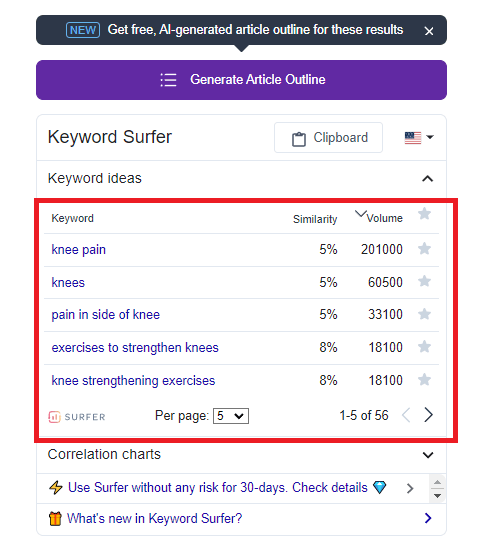
Keywords Everywhere shows you the estimated monthly traffic, number of words, and keywords used in your competitor’s blog posts. These details can be found under the title of each search result on Google.

Want to learn how to choose and find relevant keywords manually? Read our blog post on How To Find the Right Physical Therapy Keywords to learn more.
2. Write a title that gets high-click through rate (CTR)
The key to having a title that gets a high CTR is wording it in a way that catches the attention of your audience. Here are some of the steps to guide you:
- Your title should start with the keyword that you are going for
- Include words that have a positive or negative sentiment (e.g. best, worst)
- Should have power words in it (e.g. achieve, excellent, shocking)
- use numbers (e.g. current year, Top 10…, 5 Ways to…)
Learn more about ways you can market your physical therapy clinic using effective tools.
3. Optimize meta descriptions
Meta descriptions are the sentences that you usually see underneath a search engine result. It describes what your blog post is all about. When writing meta descriptions, it’s important that you use relevant keywords in them because they can help you generate more clicks.
Things to remember when writing meta descriptions:
- Make sure to use your primary keyword in your physical therapy blog post’s meta description. This will help Google get used to your content. Just don’t overuse it.
- Keep it concise but full of impact.
4. Use images
Images make your physical therapy blog posts easier to digest and make them more captivating especially if it has lots of text. Adding several images can help your readers fully consume your blog posts until the end. Some of the websites where you can get a lot of PT-related photos are Unsplash, Pixabay, and Pexels.
5. Add internal and external links
Links can be very useful to your physical therapy blog posts. It helps your readers gain relevant information about your piece and not just that, but it also helps you build authority. The recommended number of links that you should have on your blog posts is somewhere between 3-5 for internal links and 2-4 outbound links for every 1,000 words.
6. Use active voice
Excessive use of passive voice can make your content complicated to read. Active voice makes your blog posts engaging to read, increases conversions, and also creates an emotional impact with your readers. Hemingway Editor can help you spot passive voice in your blog posts.
7. Add a call to action (CTA)
In every blog post, there should be at least two CTA buttons. This will serve as a guide for your readers on the next action to take. But, before that, you should also write a relevant sentence that leads your page visitors to the call to action button so they’ll be encouraged to take action.
Some of the CTA buttons you want to include in your physical therapy blog posts are the following:
- “Subscribe now”
- “Download now”
- “Get On A Call With Us”
- “Book An Appointment”
8. Create a schedule for publishing
As a physical therapist, you want to be consistent in publishing blog posts despite having a busy schedule in the clinic. This will not only help create a sense of trust with your audience, but it will also help you become recognized in the field of physical therapy.
Creating a blog schedule could really help you stick to a regular schedule of publishing posts and help you not miss out on the dates that you should be sharing your content with your audience.
Writing your first blog post can be quite overwhelming. Our friendly team is here to help.
Conclusion
Coming up with a great blog post can be a daunting task especially if you haven’t tried it before. But if done right, you will surely notice an improvement in your web traffic which can also lead to conversions. Just follow the best practices we’ve mentioned earlier and you’re good to go!






